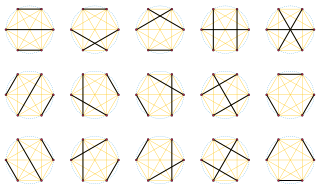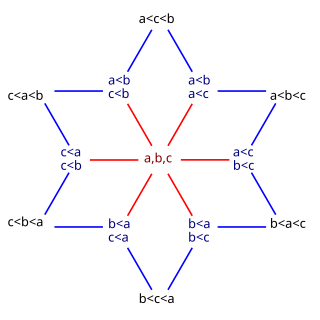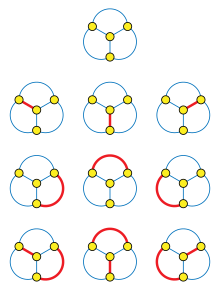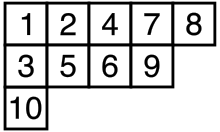
In number theory and combinatorics, a partition of a non-negative integer n, also called an integer partition, is a way of writing n as a sum of positive integers. Two sums that differ only in the order of their summands are considered the same partition. For example, 4 can be partitioned in five distinct ways:
In mathematics, a generating function is a representation of an infinite sequence of numbers as the coefficients of a formal power series. Unlike an ordinary series, the formal power series is not required to converge: in fact, the generating function is not actually regarded as a function, and the "variable" remains an indeterminate. Generating functions were first introduced by Abraham de Moivre in 1730, in order to solve the general linear recurrence problem. One can generalize to formal power series in more than one indeterminate, to encode information about infinite multi-dimensional arrays of numbers.
In combinatorial mathematics, the Bell numbers count the possible partitions of a set. These numbers have been studied by mathematicians since the 19th century, and their roots go back to medieval Japan. In an example of Stigler's law of eponymy, they are named after Eric Temple Bell, who wrote about them in the 1930s.

In combinatorial mathematics, the Catalan numbers are a sequence of natural numbers that occur in various counting problems, often involving recursively defined objects. They are named after the French-Belgian mathematician Eugène Charles Catalan.

In mathematics, an involution, involutory function, or self-inverse function is a function f that is its own inverse,

In combinatorics, a branch of mathematics, the inclusion–exclusion principle is a counting technique which generalizes the familiar method of obtaining the number of elements in the union of two finite sets; symbolically expressed as
In mathematics, the Fibonacci polynomials are a polynomial sequence which can be considered as a generalization of the Fibonacci numbers. The polynomials generated in a similar way from the Lucas numbers are called Lucas polynomials.

In mathematics, the double factorial of a number n, denoted by n‼, is the product of all the positive integers up to n that have the same parity as n. That is,

In mathematics, a pyramid number, or square pyramidal number, is a natural number that counts the number of stacked spheres in a pyramid with a square base. The study of these numbers goes back to Archimedes and Fibonacci. They are part of a broader topic of figurate numbers representing the numbers of points forming regular patterns within different shapes.
In mathematics, the nth Motzkin number is the number of different ways of drawing non-intersecting chords between n points on a circle. The Motzkin numbers are named after Theodore Motzkin and have diverse applications in geometry, combinatorics and number theory.

In mathematics, particularly in combinatorics, a Stirling number of the second kind is the number of ways to partition a set of n objects into k non-empty subsets and is denoted by or . Stirling numbers of the second kind occur in the field of mathematics called combinatorics and the study of partitions. They are named after James Stirling.
In mathematics, especially in combinatorics, Stirling numbers of the first kind arise in the study of permutations. In particular, the Stirling numbers of the first kind count permutations according to their number of cycles.
In mathematics, poly-Bernoulli numbers, denoted as , were defined by M. Kaneko as
In combinatorial mathematics, an alternating permutation of the set {1, 2, 3, ..., n} is a permutation (arrangement) of those numbers so that each entry is alternately greater or less than the preceding entry. For example, the five alternating permutations of {1, 2, 3, 4} are:

In combinatorics, the Eulerian number is the number of permutations of the numbers 1 to in which exactly elements are greater than the previous element.

In number theory and enumerative combinatorics, the ordered Bell numbers or Fubini numbers count the number of weak orderings on a set of elements. Weak orderings arrange their elements into a sequence allowing ties, such as might arise as the outcome of a horse race). Starting from , these numbers are
In combinatorial mathematics, a rook polynomial is a generating polynomial of the number of ways to place non-attacking rooks on a board that looks like a checkerboard; that is, no two rooks may be in the same row or column. The board is any subset of the squares of a rectangular board with m rows and n columns; we think of it as the squares in which one is allowed to put a rook. The board is the ordinary chessboard if all squares are allowed and m = n = 8 and a chessboard of any size if all squares are allowed and m = n. The coefficient of x k in the rook polynomial RB(x) is the number of ways k rooks, none of which attacks another, can be arranged in the squares of B. The rooks are arranged in such a way that there is no pair of rooks in the same row or column. In this sense, an arrangement is the positioning of rooks on a static, immovable board; the arrangement will not be different if the board is rotated or reflected while keeping the squares stationary. The polynomial also remains the same if rows are interchanged or columns are interchanged.
In mathematics, the Robinson–Schensted–Knuth correspondence, also referred to as the RSK correspondence or RSK algorithm, is a combinatorial bijection between matrices A with non-negative integer entries and pairs (P,Q) of semistandard Young tableaux of equal shape, whose size equals the sum of the entries of A. More precisely the weight of P is given by the column sums of A, and the weight of Q by its row sums. It is a generalization of the Robinson–Schensted correspondence, in the sense that taking A to be a permutation matrix, the pair (P,Q) will be the pair of standard tableaux associated to the permutation under the Robinson–Schensted correspondence.

In combinatorics, the Schröder–Hipparchus numbers form an integer sequence that can be used to count the number of plane trees with a given set of leaves, the number of ways of inserting parentheses into a sequence, and the number of ways of dissecting a convex polygon into smaller polygons by inserting diagonals. These numbers begin
In the theory of permutation patterns, a skew-merged permutation is a permutation that can be partitioned into an increasing sequence and a decreasing sequence. They were first studied by Stankova (1994) and given their name by Atkinson (1998).
























